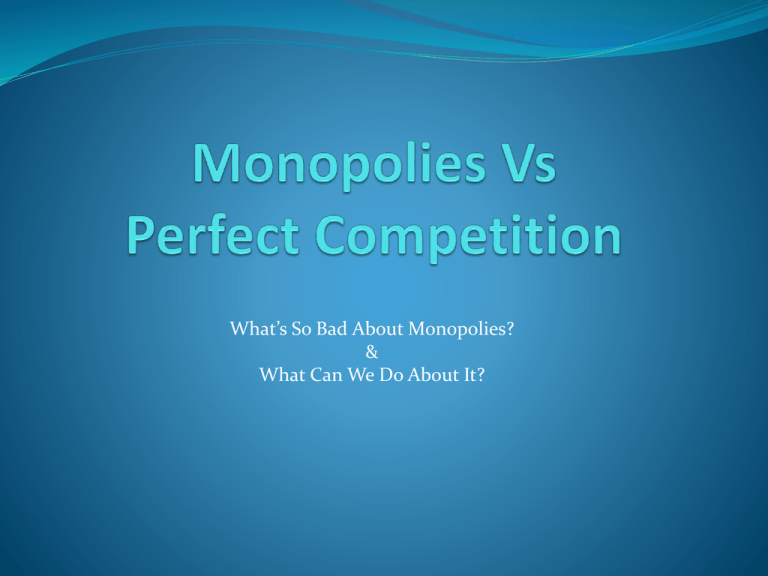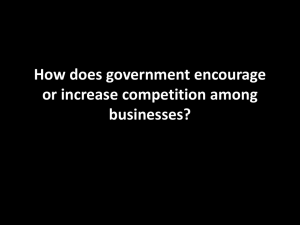What’s So Bad About Monopolies? & What Can We Do About It?
advertisement

What’s So Bad About Monopolies? & What Can We Do About It? What’s So Bad About Monopolies Martin Shkreli In September 2015, Shkreli received widespread criticism when Turing obtained the manufacturing license for the antiparasitic drug Daraprim and raised its price by 5,556 percent (from US$13.50 to US$750 per tablet) leading him to be referred to by media as the "most hated man in America".[4] What’s So Bad About Monopolies? Compared to Perfect Competition Higher Price for Fewer Goods Don’t face competition – no substitutes Do have to take into account that their production level (quantity supplied) affects the price customers are willing to pay Choose profit max’ing output to max profits Choose Q* such that MC(Q*) = MR(Q*) Remember for monopolist P > MR What’s So Bad About Monopolies? Compared to Perfect Competition Higher Price for Fewer Goods Economic Considerations P > MC Consumer’s value (MV) of Q* > Cost (MC) of resources used Thus -> Deadweight Loss (Economic Inefficiency) Allocatively Inefficient Q* not produced at lowest cost (ATC > min(ATC)) Productively Inefficient Little Incentive to Adopt New Technology No competition -> no incentive to adopt new tech & reduce cost How Did It Happen? Monopoly Firm that is the sole seller of a product without close substitutes Barriers to entry – prevent firms from entering this market when there are + economic profits Legal and Cost Barriers NBA, Medical, Patents (pharmaceutical) Monopoly resources Oil, Diamonds, Professional Sports Government regulation Comcast High Cost Barriers to Enter the Market – Aerospace Big Pharma Big Pharma Is America’s New Mafia Pharmaceutical companies have more power than ever, and the American people are paying the price—too often with our lives. http://time.com/3700497/john-oliver-last-week- tonight-big-pharma/ Professional Sports At the federal level, antitrust legislation serves as one culprit in the city-switching games played by teams. Pro sports leagues have been classified by government officials as monopolies, and are therefore subject to antitrust regulation. The exception to this has been Major League Baseball, which operates under an antitrust exemption, and indeed, baseball teams remain far less mobile than, for example, NFL teams. Aerospace Boeing and Airbus – Market Share How Do We “Fix” Monopolies Lower Barriers to Entry Goal is to increase competition by allowing more firms to enter the market and compete against each other AT&T Divestiture (1980) DOJ and FCC sought to introduce competition into the local phone markets (dominated by 7 RBOCs, “bab y bells”) Required AT&T/RBOCs to lease local wirelines, switching networks, transmission satellites and local household connections at “forward” looking economic costs (which were below historical costs) AT&T and the Baby Bells Before After How Do We “Fix” Monopolies AT&T Before and After the Break-up After the Break Up Colbert on the AT&T Break-Up http://www.ebaumsworld.com/video/watch /955486/ Why Monopolies Arise The production process A single firm can produce output at a lower cost than can a larger number of producers Natural monopoly Arises because a single firm can supply a good or service to an entire market At a smaller cost than could two or more firms Economies of scale over the relevant range of output 15 1 Economies of scale as a cause of monopoly Costs Average total cost 0 Quantity of output When a firm’s average-total-cost curve continually declines, the firm has what is called a natural monopoly. In this case, when production is divided among more firms, each firm produces less, and average total cost rises. As a result, a single firm can produce any given amount at the smallest cost 16 Natural Monopoly – Avg Cost Decrease with Increasing Size/Scale of the Firm – Divestiture Raises Avg Cost Average Total Cost ATC in short run with small factory ATC in short run with medium factory ATC in short run with large factory ATC in long run 6 $12,000 10,000 Economies of scale 0 Constant returns to scale 1,000 1,200 Diseconomies of scale Quantity of Cars per Day Because fixed costs are variable in the long run, the average-total-cost curve in the short run differs from the average-total-cost curve in the long run. 17 AT&T – A Short History Alexander Graham Bell patented the telephone in 1876, formed Bell Telephone which licensed local telephone exchanges in major US cities. AT&T was formed in 1885 In 1913 AT&T became a regulated monopoly. had to connect competing local companies And let the Federal Communication Commission (FCC) approve their prices and policies. All customers rented phones from AT&T, and no other equipment could be attached to the network for fear of "breaking" it. AT&T – A Short History On January 1, 1984, a court forced AT&T to give up its 22 local Bell companies (Divestiture) This established seven Regional Bell Operating Companies (RBOC). Since that time, mergers have reduced the number of RBOCs to four: Verizon (originally Bell Atlantic and Nynex), Qwest (Qwest Communications International took over US West), BellSouth and SBC (originally Southwestern Bell and Pacific Telesys). The New Market - Wireless Wireless Customers- by Carrier And Then There is Comcast & Time-Warner – Cable Companies And Then There is Comcast & Time-Warner Monopolies – Antitrust Law Increasing competition with antitrust laws Sherman Antitrust Act, 1890 Reduce the market power of trusts Clayton Antitrust Act, 1914 Strengthened government’s powers Authorized private lawsuits Prevent mergers Break up companies Prevent companies from coordinating their activities to make markets less competitive 25 Public Policy Toward Monopolies Regulation Regulate the behavior of monopolists Price – don’t allow P > MC Issue – Firms have all of the data on their prices – may not disclose accurate information Common in case of natural monopolies Marginal-cost pricing 26 May be less than ATC No incentive to reduce costs





